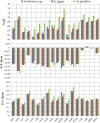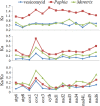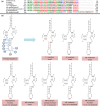Comparative mitochondrial genomic analyses of three chemosynthetic vesicomyid clams from deep-sea habitats
- PMID: 30151147
- PMCID: PMC6106168
- DOI: 10.1002/ece3.4153
Comparative mitochondrial genomic analyses of three chemosynthetic vesicomyid clams from deep-sea habitats
Abstract
Vesicomyid clams of the subfamily Pliocardinae are among the dominant chemosymbiotic bivalves found in sulfide-rich deep-sea habitats. Plastic morphologies and present molecular data could not resolve taxonomic uncertainties. The complete mitochondrial (mt) genomes will provide more data for comparative studies on molecular phylogeny and systematics of this taxonomically uncertain group, and help to clarify generic classifications. In this study, we analyze the features and evolutionary dynamics of mt genomes from three Archivesica species (Archivesica sp., Ar. gigas and Ar. pacifica) pertaining to subfamily Pliocardinae. Sequence coverage is nearly complete for the three newly sequenced mt genomes, with only the control region and some tRNA genes missing. Gene content, base composition, and codon usage are highly conserved in these pliocardiin species. Comparative analysis revealed the vesicomyid have a relatively lower ratio of Ka/Ks, and all 13 protein-coding genes (PGCs) are under strong purifying selection with a ratio of Ka/Ks far lower than one. Minimal changes in gene arrangement among vesicomyid species are due to the translocation trnaG in Isorropodon fossajaponicum. Additional tRNA genes were detected between trnaG and nad2 in Abyssogena mariana (trnaL3), Ab. phaseoliformis (trnaS3), and Phreagena okutanii (trnaM2), and display high similarity to other pliocardiin sequences at the same location. Single base insertion in multiple sites of this location could result in new tRNA genes, suggesting a possible tRNA arising from nongeneic sequence. Phylogenetic analysis based on 12 PCGs (excluding atp8) supports the monophyly of Pliocardiinae. These nearly complete mitogenomes provide relevant data for further comparative studies on molecular phylogeny and systematics of this taxonomically uncertain group of chemosymbiotic bivalves.
Keywords: chemosymbiotic bivalves; deep‐sea; gene arrangement; mitochondrial genome; vesicomyid clams.
Figures







Similar articles
-
The complete mitochondrial genome of Calyptogena marissinica (Heterodonta: Veneroida: Vesicomyidae): Insight into the deep-sea adaptive evolution of vesicomyids.PLoS One. 2019 Sep 19;14(9):e0217952. doi: 10.1371/journal.pone.0217952. eCollection 2019. PLoS One. 2019. PMID: 31536521 Free PMC article.
-
Updated mitochondrial phylogeny of Pteriomorph and Heterodont Bivalvia, including deep-sea chemosymbiotic Bathymodiolus mussels, vesicomyid clams and the thyasirid clam Conchocele cf. bisecta.Mar Genomics. 2017 Feb;31:43-52. doi: 10.1016/j.margen.2016.09.003. Epub 2016 Oct 6. Mar Genomics. 2017. PMID: 27720682
-
Ancient Occasional Host Switching of Maternally Transmitted Bacterial Symbionts of Chemosynthetic Vesicomyid Clams.Genome Biol Evol. 2017 Sep 1;9(9):2226-2236. doi: 10.1093/gbe/evx166. Genome Biol Evol. 2017. PMID: 28922872 Free PMC article.
-
Morphological and functional characterization of hemocytes from two deep-sea vesicomyid clams Phreagena okutanii and Abyssogena phaseoliformis.Fish Shellfish Immunol. 2018 Mar;74:281-294. doi: 10.1016/j.fsi.2017.12.058. Epub 2018 Jan 2. Fish Shellfish Immunol. 2018. PMID: 29305332
-
Complete mitochondrial genomes of Thyreophagus entomophagus and Acarus siro (Sarcoptiformes: Astigmatina) provide insight into mitogenome features, evolution, and phylogeny among Acaroidea mites.Exp Appl Acarol. 2022 Sep;88(1):57-74. doi: 10.1007/s10493-022-00745-4. Epub 2022 Oct 18. Exp Appl Acarol. 2022. PMID: 36255591 Review.
Cited by
-
A faunal inventory of methane seeps on the Pacific margin of Costa Rica.Zookeys. 2025 Jan 3;1222:1-250. doi: 10.3897/zookeys.1222.134385. eCollection 2025. Zookeys. 2025. PMID: 39877055 Free PMC article.
-
Complete Mitogenomes of Ticks Ixodes acutitarsus and Ixodes ovatus Parasitizing Giant Panda: Deep Insights into the Comparative Mitogenomic and Phylogenetic Relationship of Ixodidae Species.Genes (Basel). 2022 Nov 6;13(11):2049. doi: 10.3390/genes13112049. Genes (Basel). 2022. PMID: 36360286 Free PMC article.
-
Size does matter: Parallel evolution of adaptive thermal tolerance and body size facilitates adaptation to climate change in domestic cattle.Ecol Evol. 2018 Oct 5;8(21):10608-10620. doi: 10.1002/ece3.4550. eCollection 2018 Nov. Ecol Evol. 2018. PMID: 30464832 Free PMC article.
-
The complete mitochondrial genome of Calyptogena marissinica (Heterodonta: Veneroida: Vesicomyidae): Insight into the deep-sea adaptive evolution of vesicomyids.PLoS One. 2019 Sep 19;14(9):e0217952. doi: 10.1371/journal.pone.0217952. eCollection 2019. PLoS One. 2019. PMID: 31536521 Free PMC article.
References
-
- Bonnaud, L. , Boucher‐Rodoni, R. , & Monnerot, M. (1994). Phylogeny of decapod cephalopods based on partial 16S rDNA nucleotide sequences. Comptes rendus de l'Academie des sciences. Serie III, Sciences de la vie, 317, 581–588. - PubMed
LinkOut - more resources
Full Text Sources
Other Literature Sources
Research Materials

